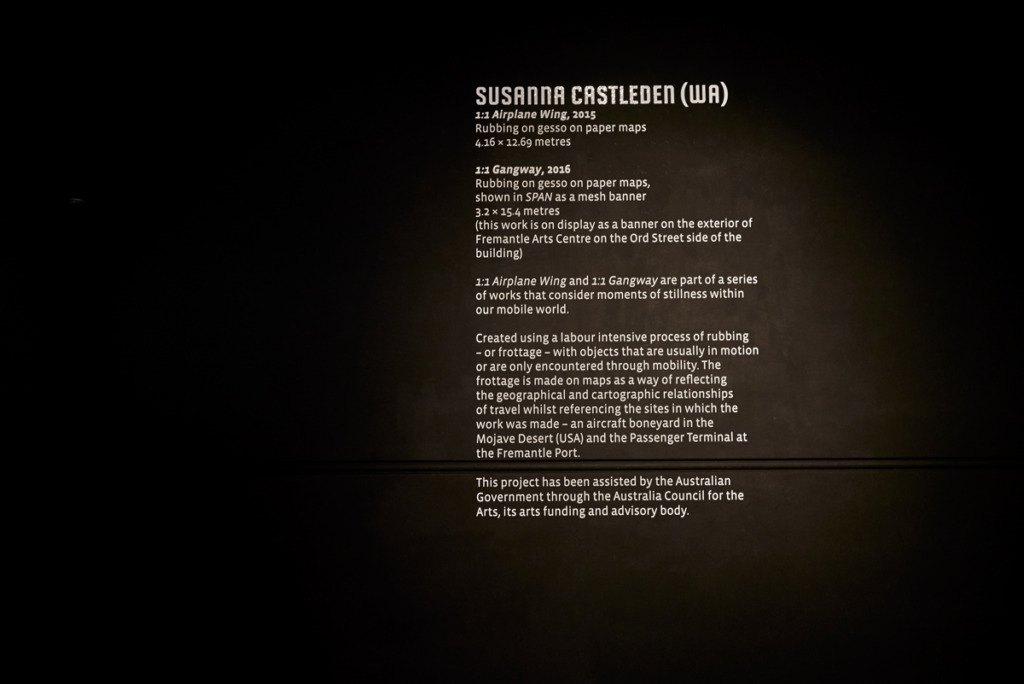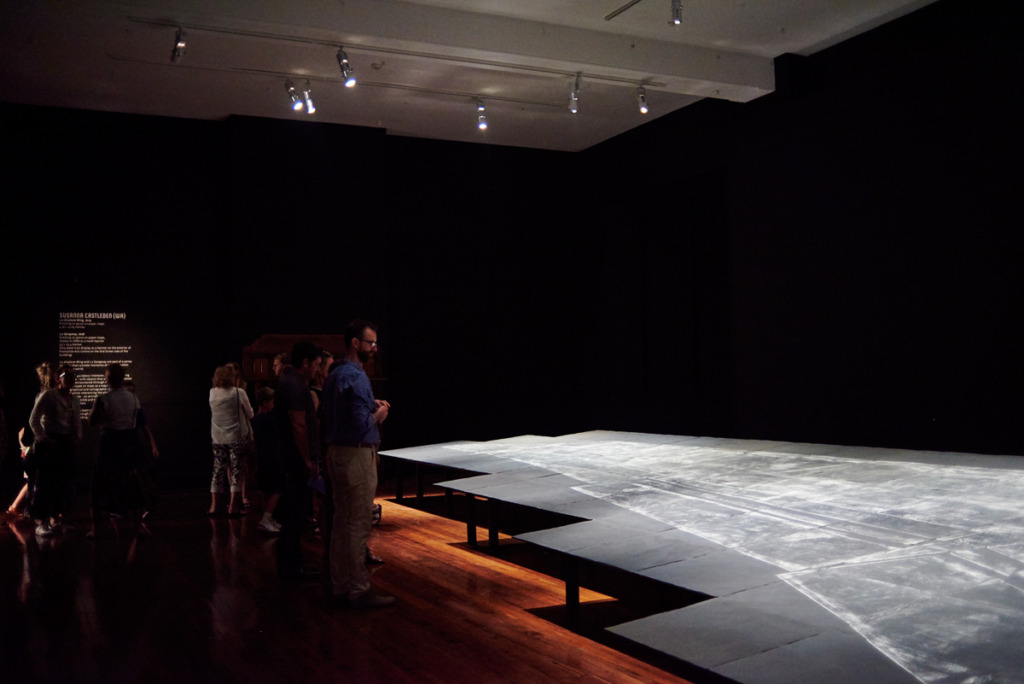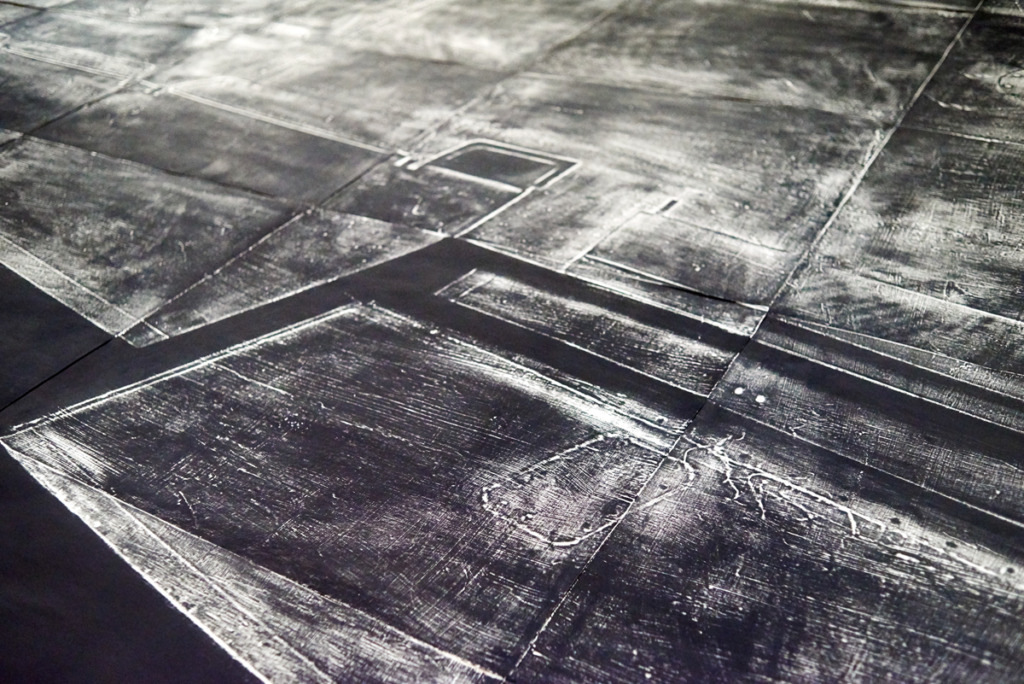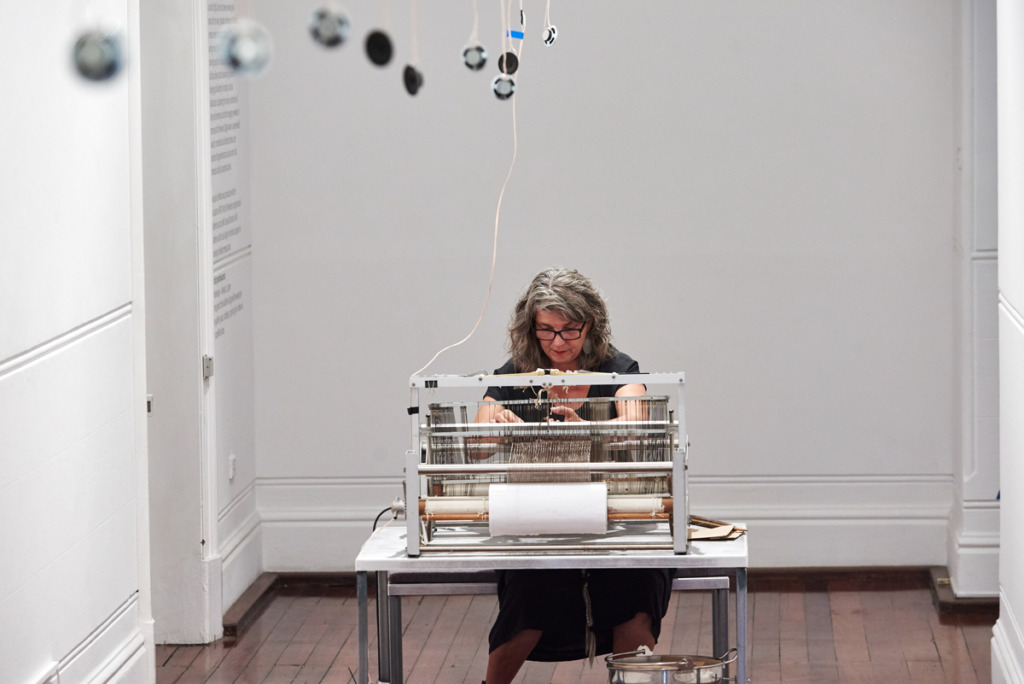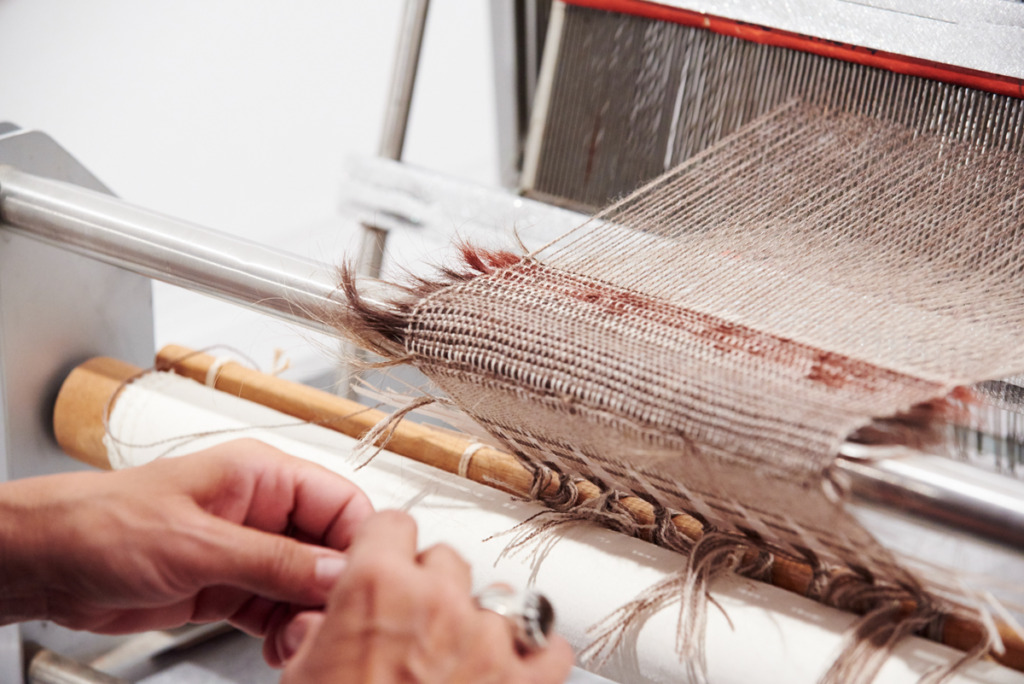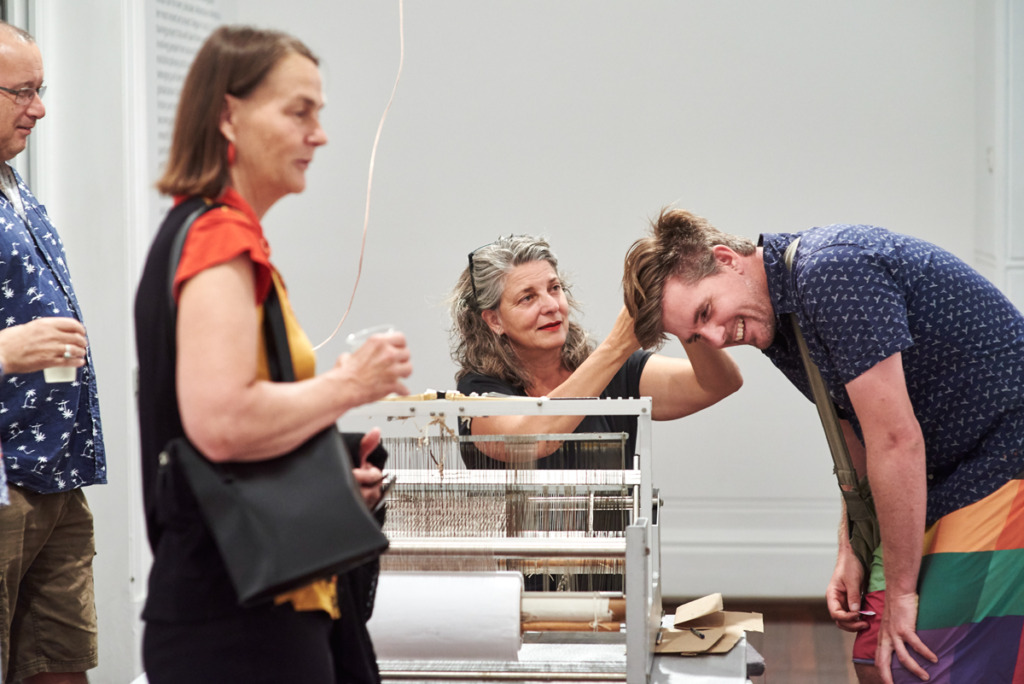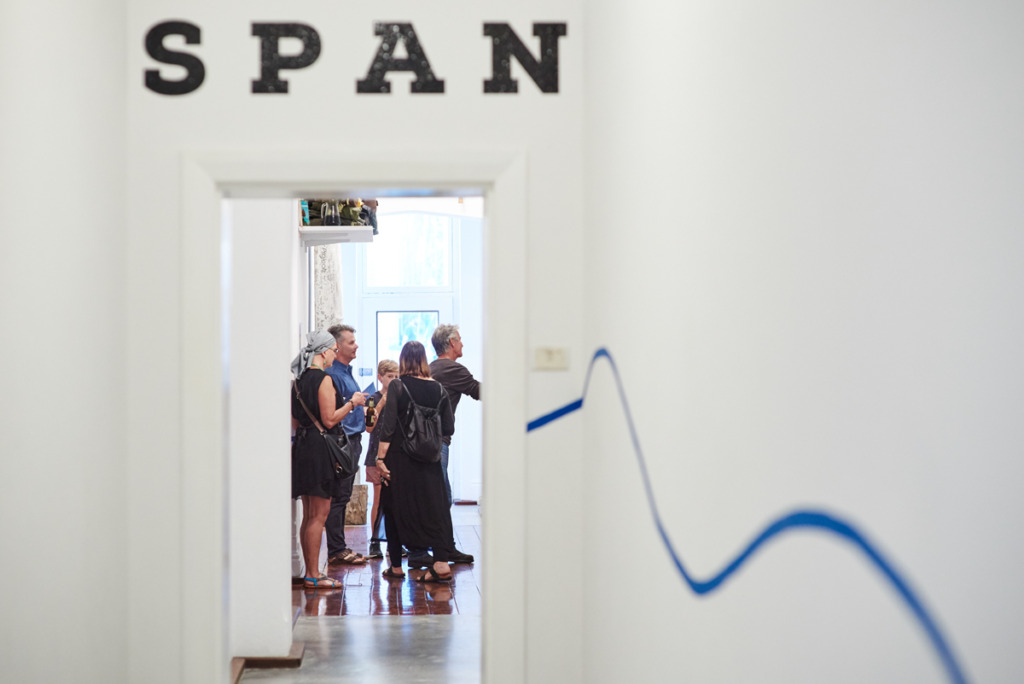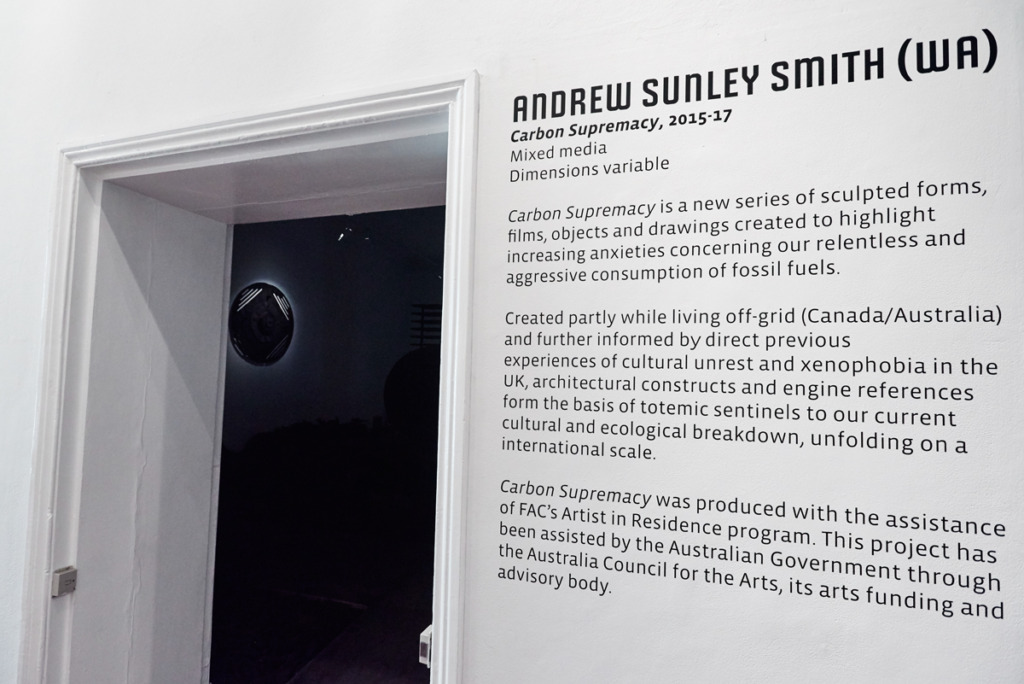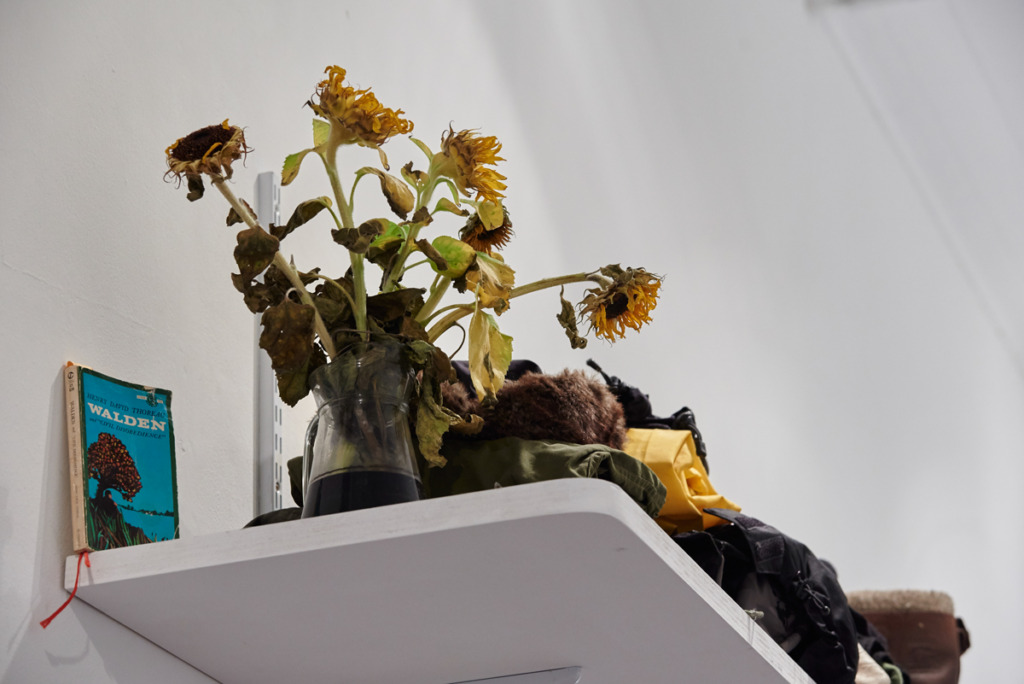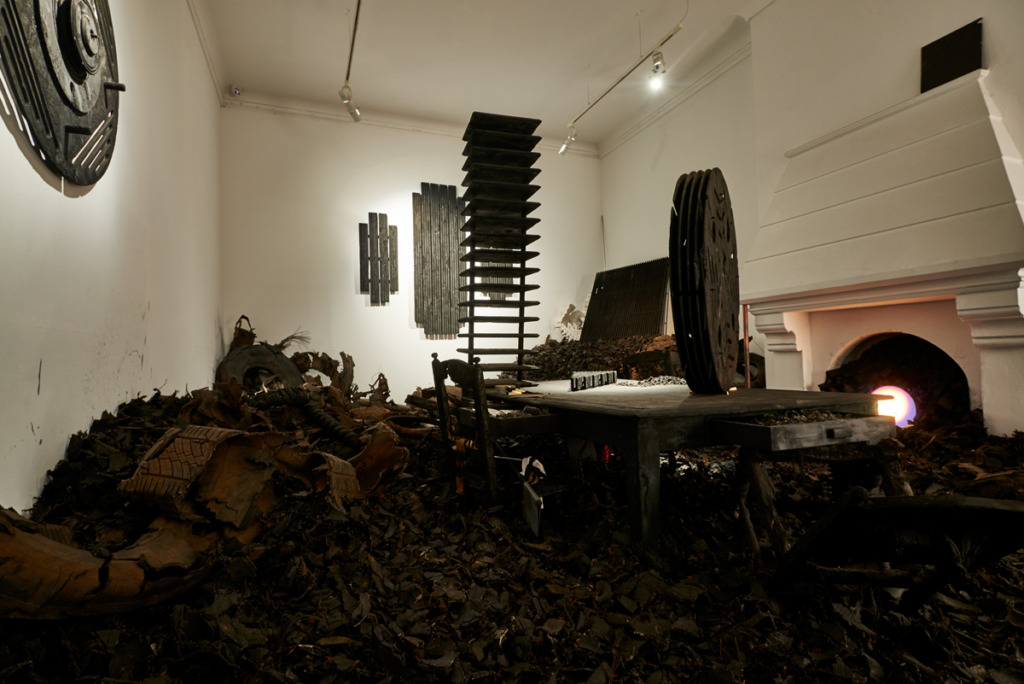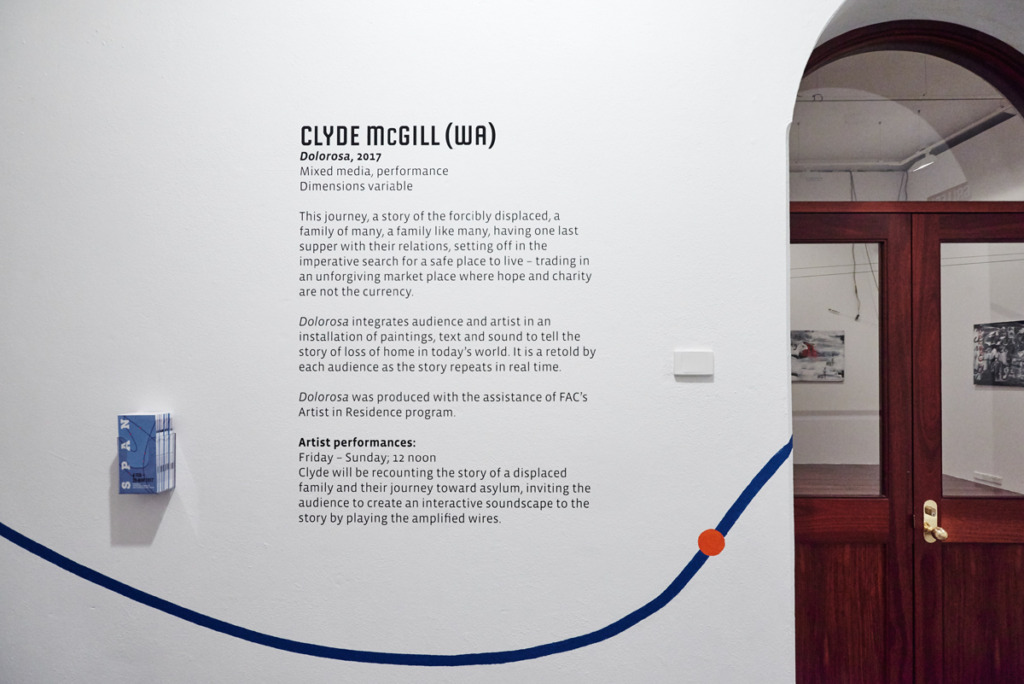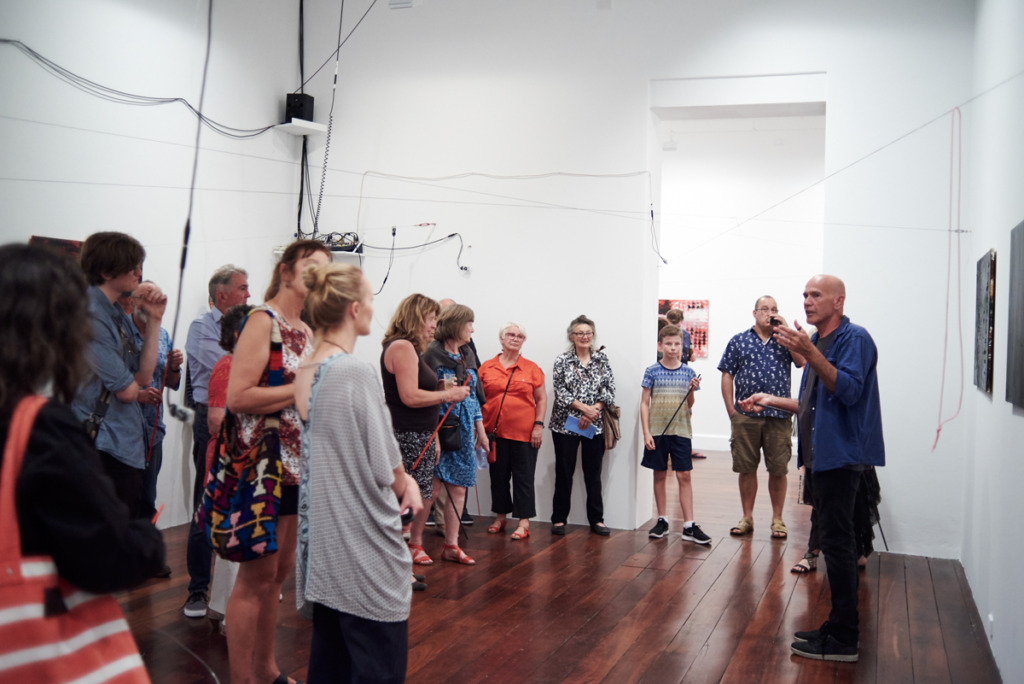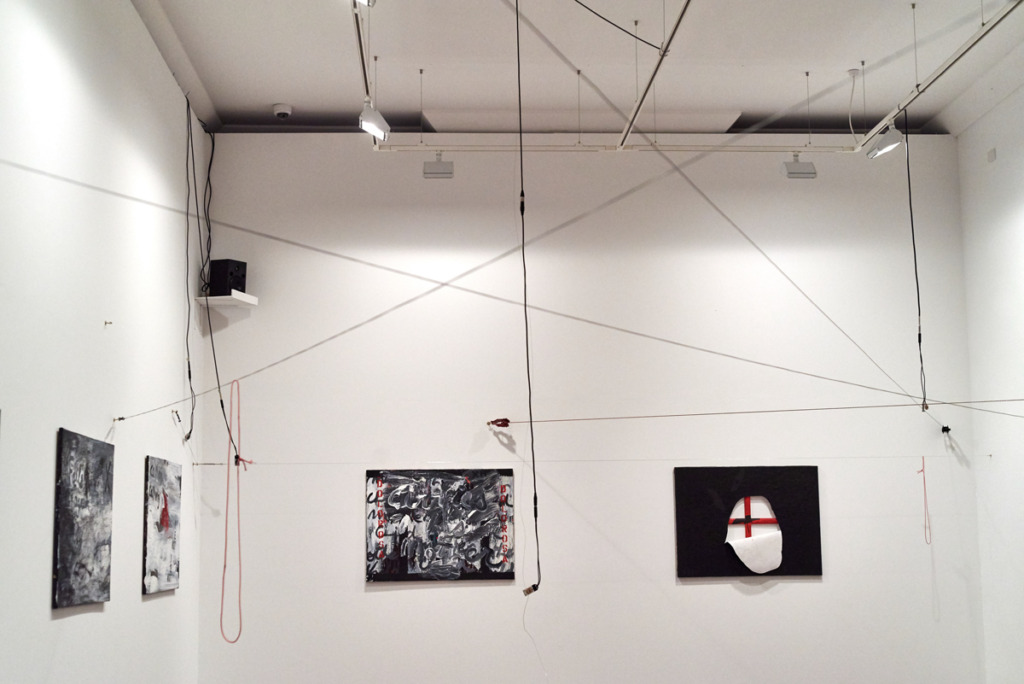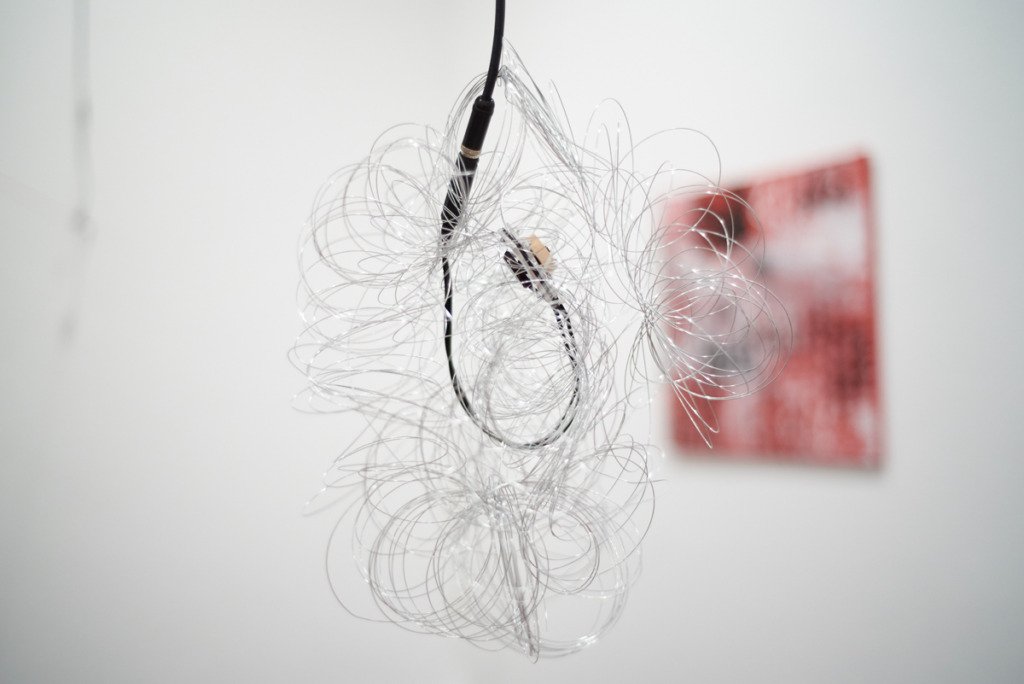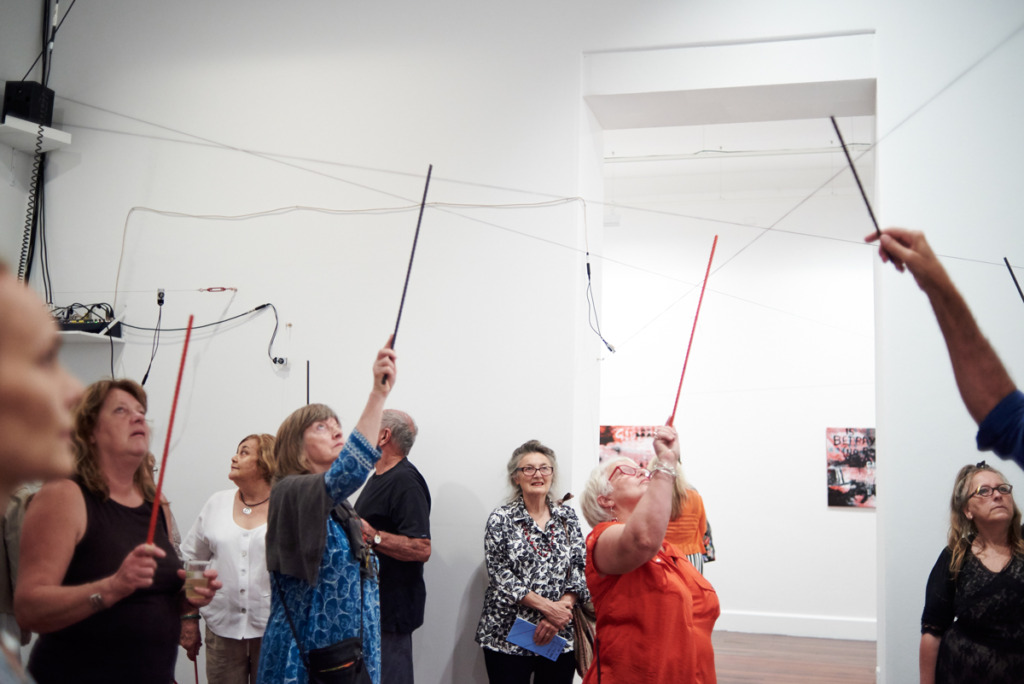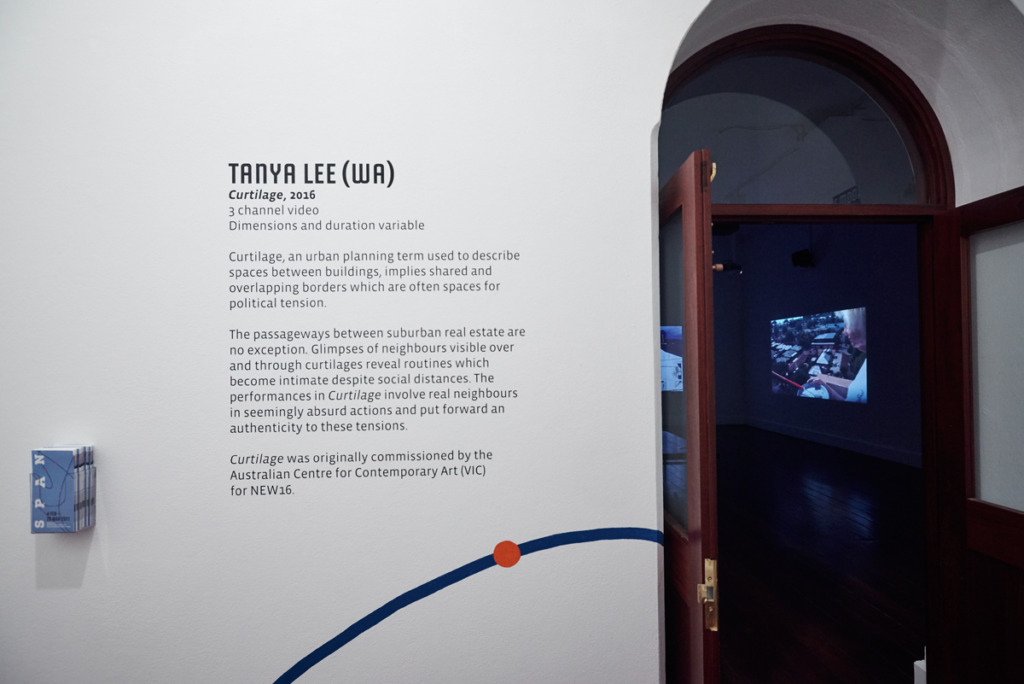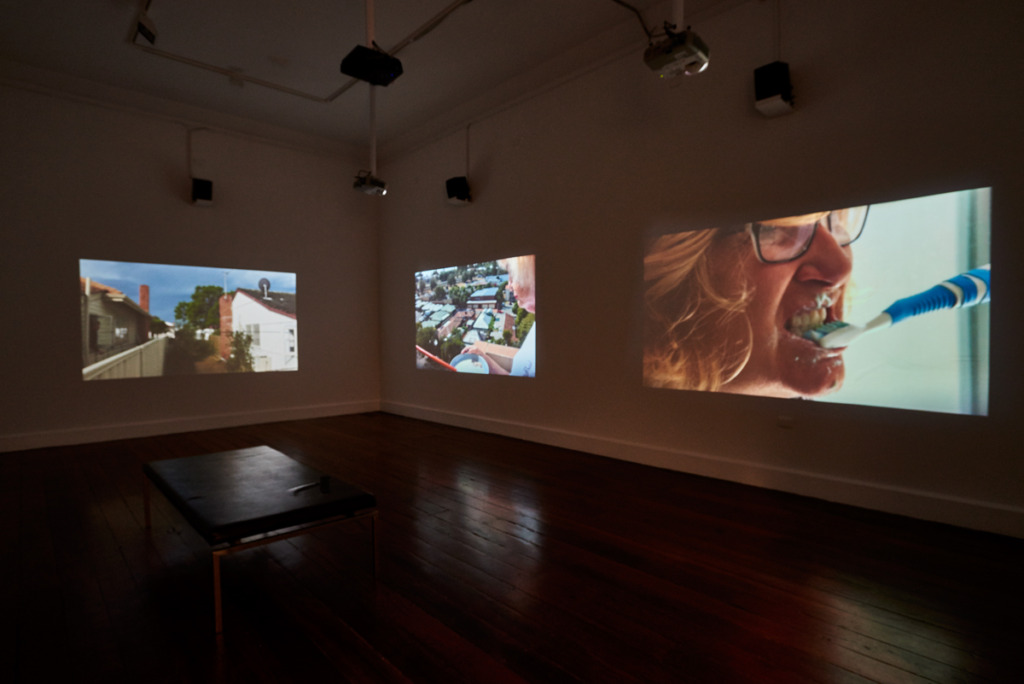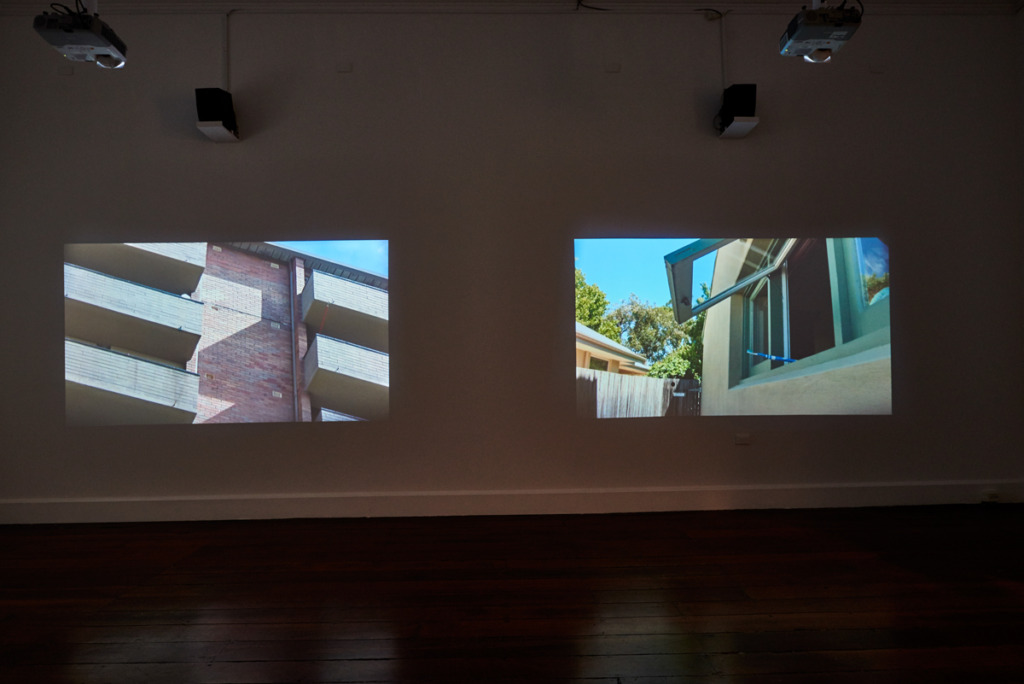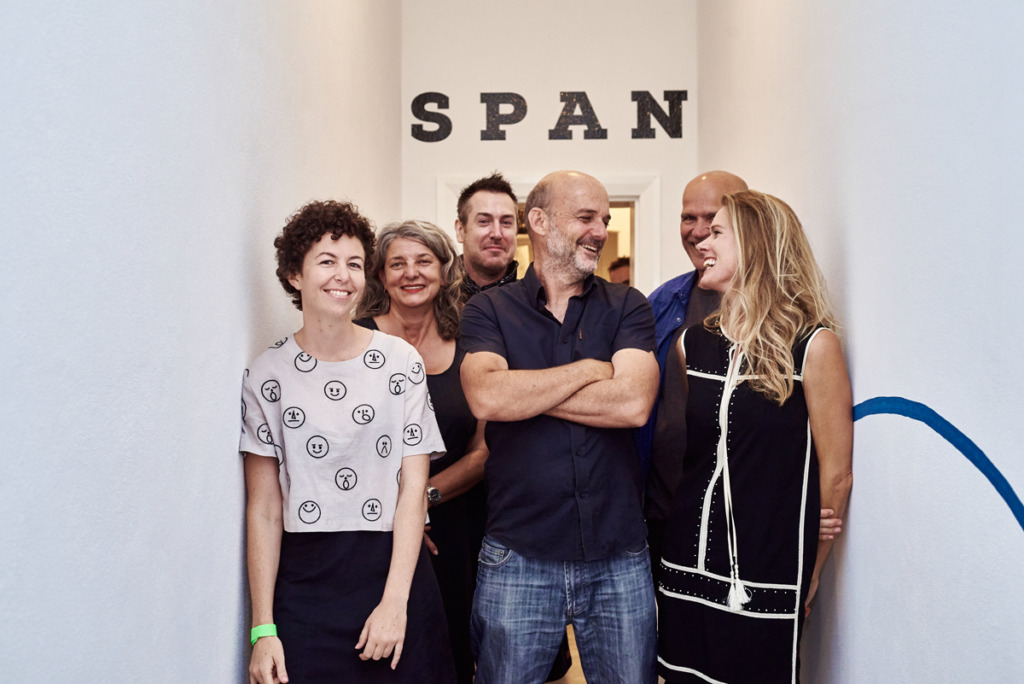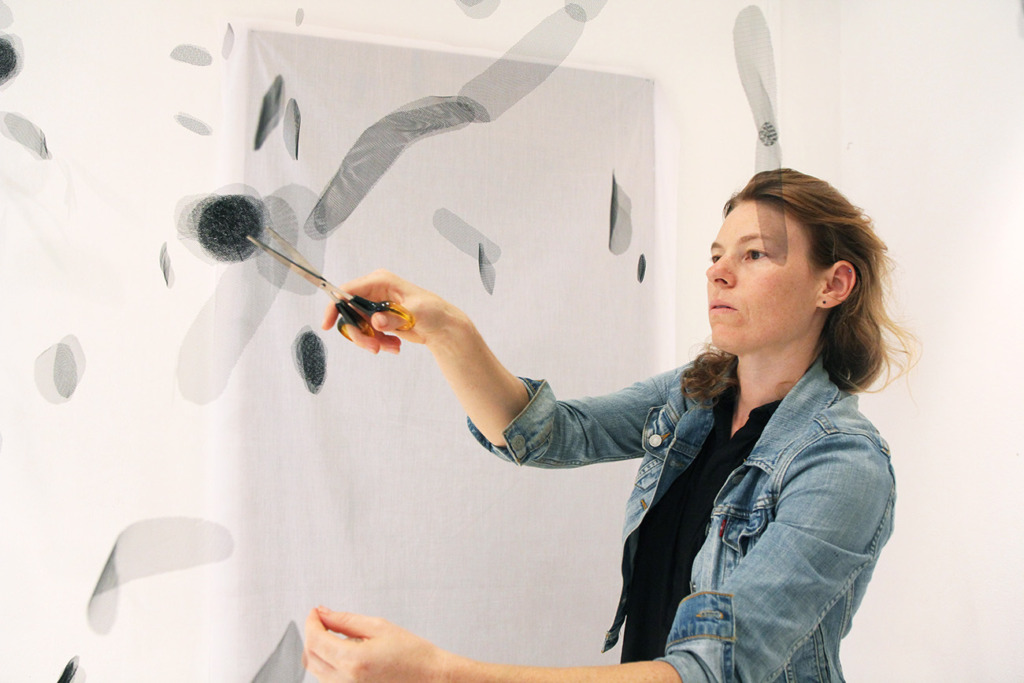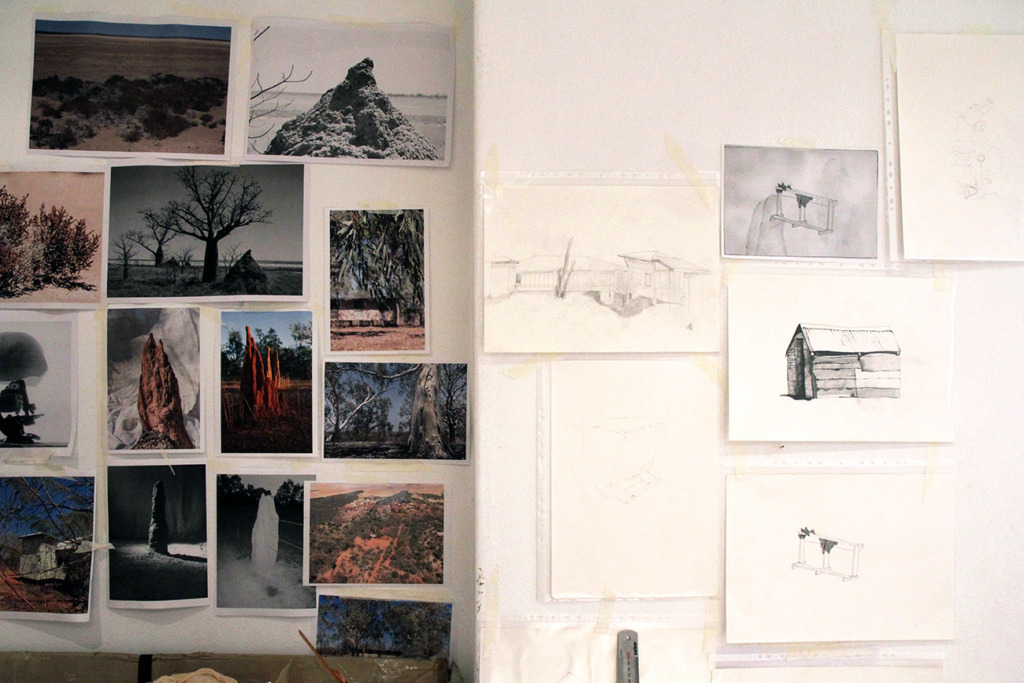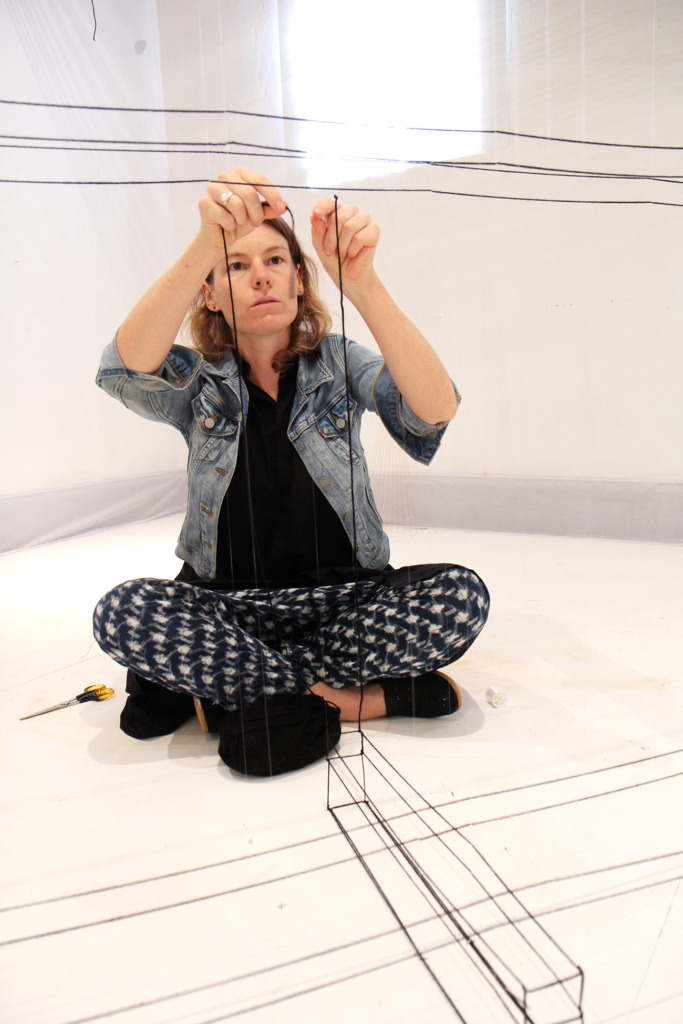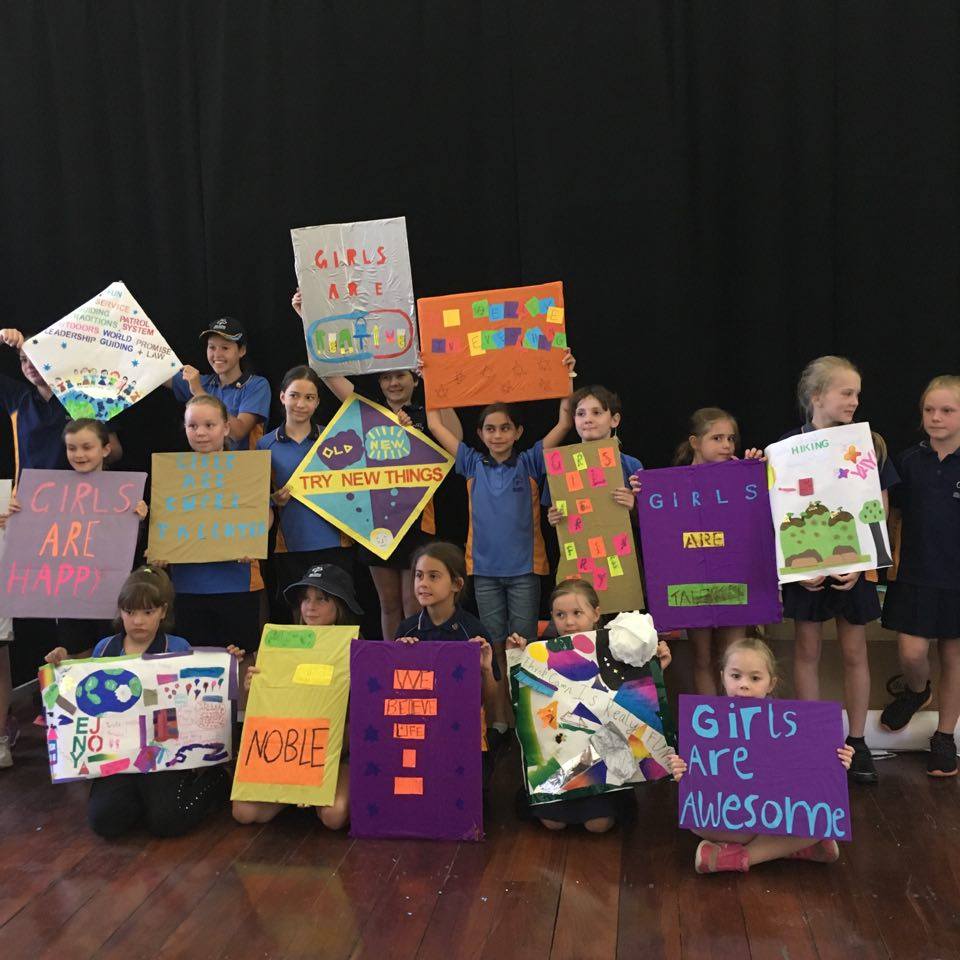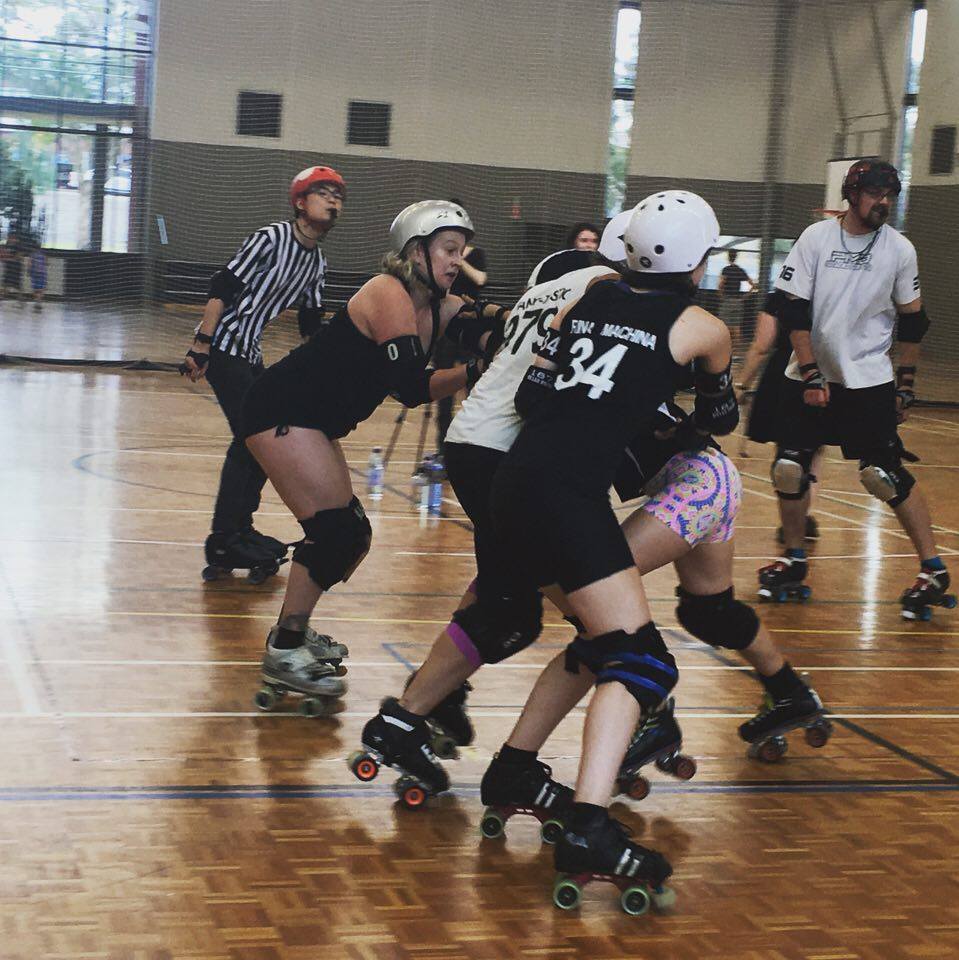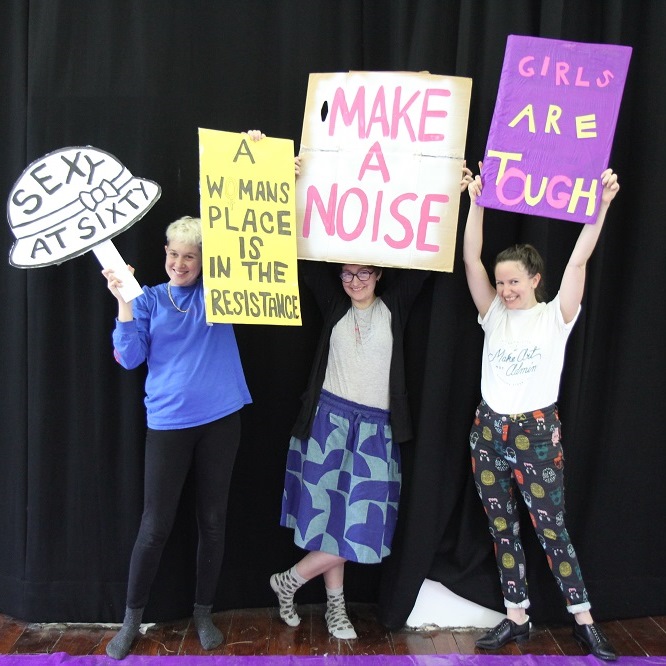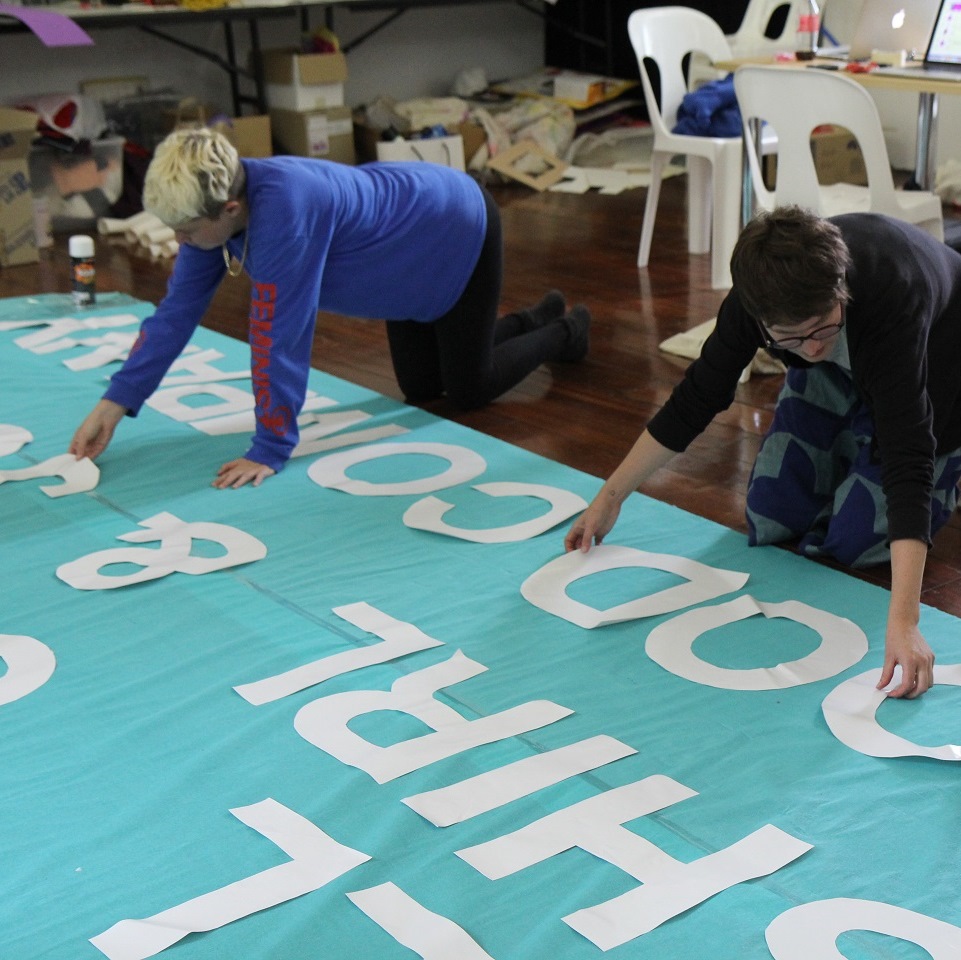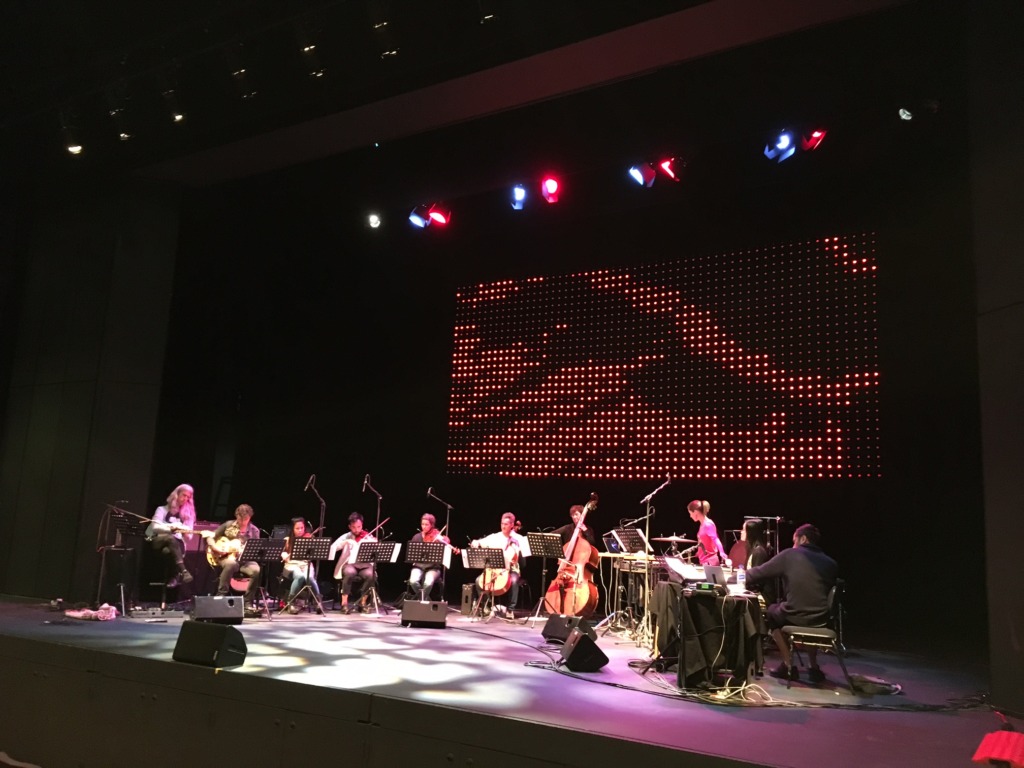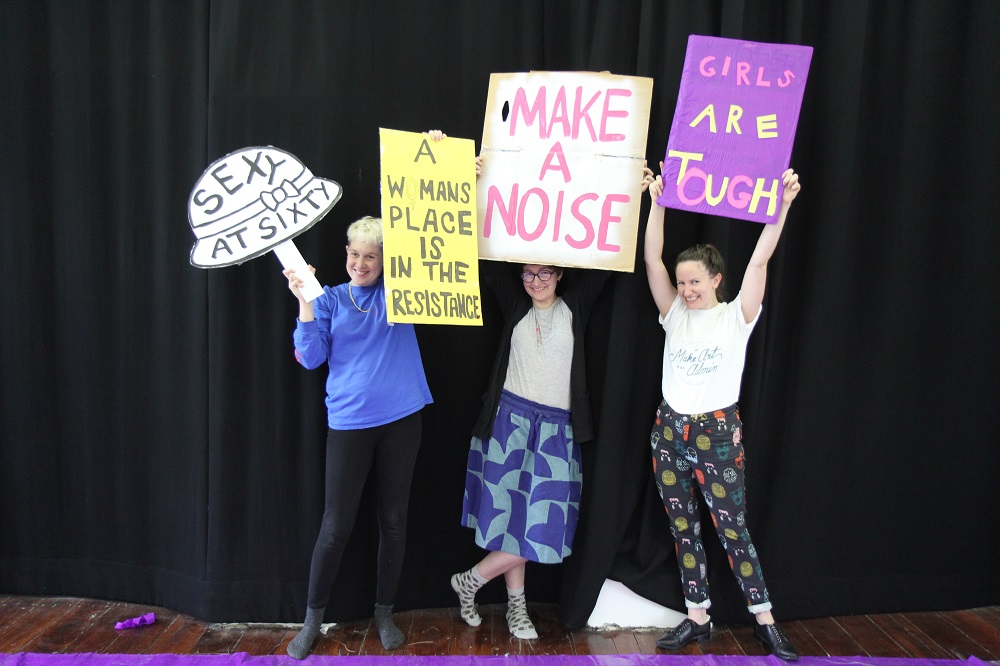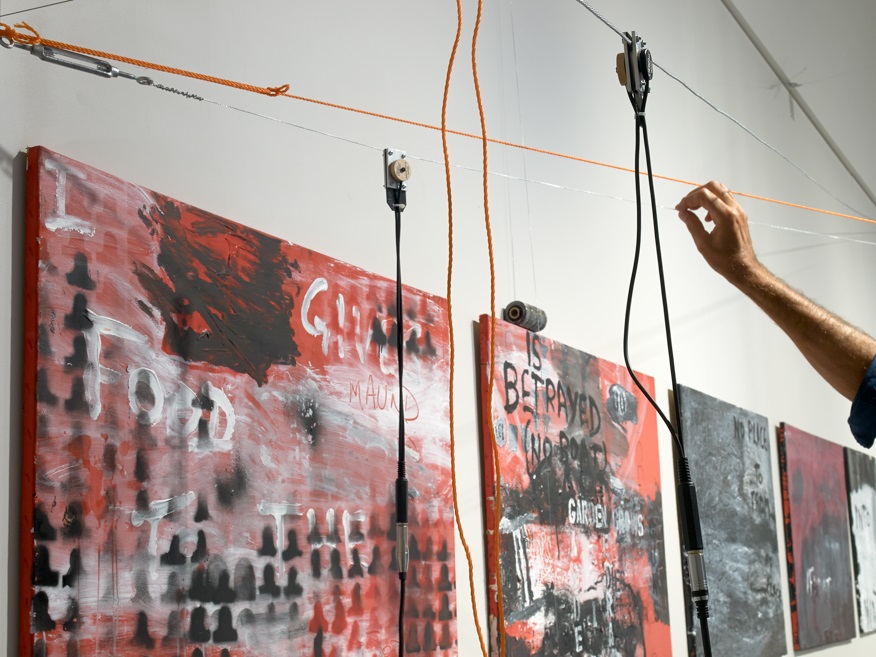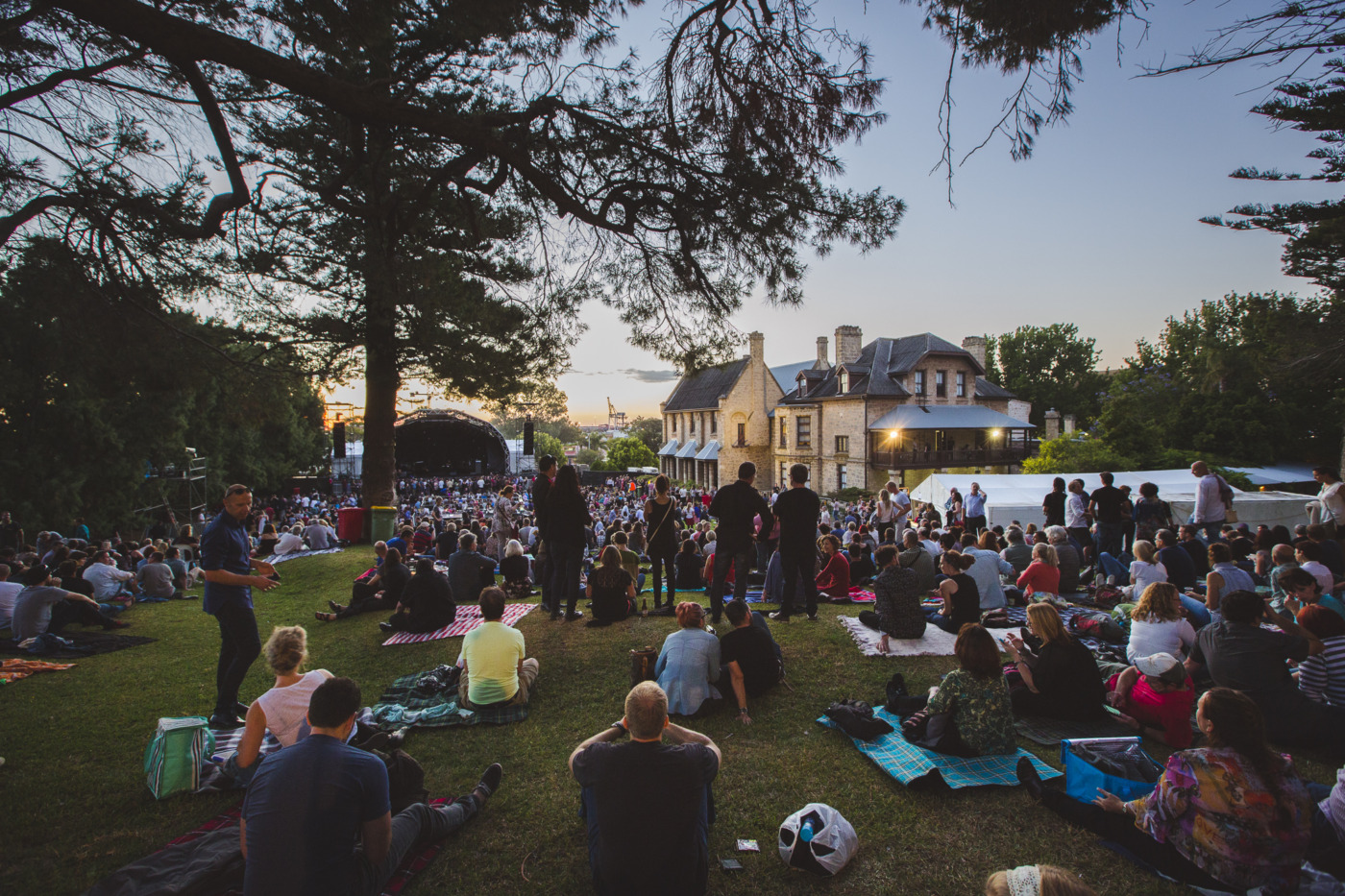Get a behind the scenes look at our 2017 Perth International Arts Festival exhibition SPAN with FAC Curator Ric Spencer. SPAN traverses the emotional, spatial and politicised boundaries of our contemporary environment, comprising work from leading WA artists Susanna Castleden, Andrew Sunley Smith, Olga Cironis, Clyde McGill and Tanya Lee.
SPAN Photo Gallery
Photos by Rebecca Mansell
New Zealand’s Katie Breckon filled us in on her time in residence at FAC, ahead of her Open Studio this Friday and Saturday. Katie’s a multi-disciplinary artist who lives and works in the Kimberley. Over the past month she’s been creating three-dimensional drawings out of thread inspired by her experience at Bungarun, the Derby Leprosarium.
Tell us a bit about your practice and what brought you to Fremantle Arts Centre.
I work across different mediums, letting the concepts and creative process guide what materials I use for each body of work. It’s difficult to pigeonhole my practice but I generally communicate through photography and drawing, while incorporating some kind of three-dimensional element.
I live in the Kimberley on a large bush block off the grid. Our house is open plan with no air-conditioning, which during the wet season makes being productive almost impossible. Coming to Fremantle for a month has given me time and space to focus, test out ideas and connect with the Perth arts community. Fremantle Art Centre is my favourite place in Perth. It’s so peaceful and has strong community engagement.
You’ve been creating three-dimensional drawings with thread while in residence. What first inspired this practice?
I want to create drawings that activate space – sketches that can be walked around and viewed from different perspectives. Installations like this change how the viewer reads the drawing because they are literally standing within it. I like how lines become tangible and physical. Instead of generating a mark with a pencil I hold the line and move it into place, which makes more sense to me. It took a year of experimentation during art school in New Zealand in 2004 to work out my technical drawing process. This way of drawing is challenged by the characteristics of each space I work within. Concrete surfaces and extremely high ceilings can definitely make the process difficult.
What have you been drawing on-site?
My studio is filled with sketches of red earth, termite mounds, silhouettes, a prayer bench and leprosy cells. I’ve reinterpreted sketches I made on site at Bungarun, the Derby Leprosarium. Bungarun is a national heritage site, an old hospital that treated people with Hansen’s disease or leprosy from 1936-1986. Our property is very close, a short drive down a dirt road through bush and marshland. The sketches will form part of a larger exhibition called The Big Sick, a term used by Kimberley Aboriginal people to describe the disease.
What role do these historically rich locations play in your work?
Historical sites help me to understand the deeper narratives of a place. A woman from Mowanjum community first took me to Bungarun. Her mother had been a leprosy patient and she has relatives buried there. Elders told me not go to Bungarun after sunset because that is when the “old people” roam around. So the place is layered with meaning and feeling, which I draw from. I find the visual contrasts really interesting, a hospital abandoned in the middle of nowhere, archival images of nuns wearing their religious habits while caring for Aboriginal patients, human survival and loss. Many stories have been recorded about Bungarun but I am interested in what can be read from the wear and tear of what remains.
Texture seems to be a key part of your practice, translating across the multiple mediums you work with and offering an evocative sense of the environment the work was made in. Having worked in some of the most remote areas of Australia, is this sense of place something you look to capture?
Outback Australia still feels unique to me, even after five years of living in the Kimberley. I work for Mowanjum Art Centre and the artists there have taught me about ochre, its traditional uses, connection to dreamtime stories and how to collect it from the land. Now I use it within my artwork to reference place. Recently I was given some kokowai (ochre) from New Zealand that I’ll use in a photographic series. I’ve also been using ochre to dye the thread I draw with.
I’m definitely influenced by my surroundings and by what’s missing from the landscape – the absence of the familiar and how my two homes New Zealand and the Kimberley contrast each other. Living here is isolating and I’m rarely able share my experiences with friends or family. I think the stories my new work explores will be interesting to audiences outside of the Kimberley, they’re unique and part of a national narrative.
What’s up next for you?
The drawings will be taken down after the Open Studio and then I’ll fly back to the Kimberley. There are also plans for an exhibition in Perth later this year. So I’m moving into a time of completing work and applying for exhibition spaces. I’ve just installed a darkroom in my shed and am hoping to make some wetplate photographs over the coming months. Hopefully the wet season heat won’t upset the chemical process too much!
Meet Katie at her Open Studio and explore her work from 9am–5pm, Friday 17 February and 9am–3pm, Saturday 18 February. From 1–3pm Saturday there’ll be refreshments for Katie’s farewell party.
‘Here we are again
Happy as can be
All named Shirl and
Jolly good company…’
Fifty women sing in full voice, nodding their heads in time. On the tables are the remnants of a pub feast and crumpled wrapping paper. It’s the Christmas party for the Shirley Club, an international organisation with hundreds of Australian members, all of whom are called Shirley.
Lara, Renae and I are lucky enough to be invited – a rare honour not usually accorded to ‘non-Shirleys’.
‘Don’t bother asking for Shirl,’ we’re told on the phone beforehand, ‘that’ll get you nowhere.’ To lessen this confusion, each member wears a Shirley Club badge with their surname and membership number. There are 500 Australian members, but the club started here in WA. With a slogan of ‘Fun, Food & Friendship’, it aims to connect women of a similar age who, due to retirement, grown-up families and shrinking social circles, may find themselves in need of company. And jolly good company they are.
Popularised by child star Shirley Temple, the name has since fallen out of fashion and so the Shirleys tend towards the elderly. Many original members are now in nursing homes or too frail to attend club meetings. The Shirley Club website often features memorials to Shirleys recently passed away.
‘My husband’s over there,’ Shirley #3 tells me, pointing to another room. An elderly man sits quietly by himself, nursing a beer. ‘He’ll drive me home after’.
The Shirley Club is one of ten ‘girl gangs’ or ‘women’s teams’ we’re working with for Before the Siren. This event is both an opening ceremony and half-time spectacle to honour the beginning of the AFL Women’s professional league. It uses all of the masculine sports tropes of mega football games to celebrate the fact that women have been gathering in all sorts of ‘teams’ since, well, forever. On the day you can expect banners, anthems, mascots and chants, as well as a special insight into some of the most intriguing female-focused clubs in WA.
Whilst being lucky enough to meet up with gangs such as the Girl Guides (‘Girl led and Adventurous’), The WA Roller Derby (‘Bruises Are Just Derby Kisses’) and the Red Hatters (‘Not the Shy Retiring Types’), we have also sunk our teeth into learning how to make giant football banners.
The Fremantle Dockers have a huge team of dedicated volunteers who make giant crepe paper banners, often 14 metres long and six metres high, for the Dockers’ home and away games. The trick with this craft is finding the right balance between being sturdy enough to withstand the Fremantle Doctor (sea breeze) and delicate enough for players to break when they run through it. The banner team have mastered this art, and let’s just say it involves hundreds of rolls of sticky-tape and a large floor space.
Over the next month we will be in residence at Fremantle Arts Centre, buried in crepe paper and in conversation with footballers, embroiderers, motorcyclists and activists to create a spectacle on the turf of the famous Fremantle Oval. Pack a picnic, your pom-poms and your best cheering voice – and come witness the madness.
Courtesy of Perth International Arts Festival. Written by Anna Dunnill, member of Snapcat.
Before the Siren | Fremantle Oval | Doors 5pm | Show 6–7pm | Sun 19 Feb
We chatted with Soft Soft Loud Artistic Director Matthew Hoy to find out more about the history of the program, a firm favourite on the Perth International Arts Festival calendar, and find out what to expect with this year’s show Future Shock.
Tell us about Soft Soft Loud. What’s the concept behind it?
It’s music made for an occasion. Inherently collaborative, Soft Soft Loud brings together musicians to realise a truly unique listening experience for the audience. Such an experience requires exactly that of the performers – a heightened ability to listen and to respond to the moment yet remain committed to music making of the highest order.
Rather than be bound by genre or style, Soft Soft Loud can be considered part of a sound continuum – reflecting, looking immediately around and ahead of now – to ensure music is relevant today, both in how it responds to and leads us as people.
How did it first begin?
Some time ago now, FAC Director Jim Cathcart approached me to program a series of concerts that would see chamber music repertoire incorporated alongside the many other amazing musical experiences FAC offers audiences. These concerts demonstrated the excellence, depth and diversity of the WA classical music scene, and presented a platform to showcase this alongside visiting artists from elsewhere in the country and from around the globe.
As years passed, audience and critical praise grew around the collaborative aspect of the series – particularly the somewhat unlikely or unexpected artist combinations! The name Soft Soft Loud was coined and has come to embody this type of musical approach among performers and the experience for audiences that it delivers.
You’re working with renowned US composer William Brittelle for this year’s show. How did that come about and what can we expect for Soft Soft Loud: Future Shock??
I became familiar with William’s music upon discovering his 2012 album Future Shock and have continued to be captivated by how his music keeps evolving in such original and compelling ways. For me his music is emotionally attuned, rationally complex (while not alienating) and sits beautifully between the visceral and intellectual. Whatever the character or inspiration, there’s also this luminosity surrounding William’s music that I find extremely compelling and exceptional in today’s music scene.
William’s also invited Aaron Roche, his good friend and powerful musical presence from the other side of the pop/classical divide, to share the stage at Soft Soft Loud this year. Aaron’s music often features beauty startlingly juxtaposed with experimental noise. Strings, live electronics and percussion magnify that contrast, accentuating the beauty in his writing while further articulating the intertwined dissonance, so elemental to the narrative of his songs. On the other hand William’s music is reflective of his mutual love of classical, jazz, punk rock and experimental electronic music.
Together over the course of this week, William, Aaron and our own amazing musicians have created their own community that welcomes listeners to what will be a unique and compelling sound experience.
Click here for more information about Soft Soft Loud and to buy tickets
Eight years since they last toured Oz, London legends Madness are set to make a very welcome return, touring in celebration of their latest studio album Can’t Touch Us Now.
Lauded for their 2016 UK tour including performances at the Glastonbury, House of Fun Weekender and House of Common festivals, Madness bring their classic, energy-packed shows to FAC, Melbourne and Sydney this April, along with a set at Byron Bay Bluesfest.
These lively lads will showcase tracks from Can’t Touch Us Now, as well as iconic hits such as Our House, Baggy Trousers and It Must Be Love.
Tickets go on sale at midday Wed 15 Feb, available from Oztix.
Fan Club and My Live Nation members may access the pre-sale beginning 10am Mon 13 Feb.
Madness are presented by Live Nation Entertainment.
Part half-time show, part community parade – Before the Siren is a celebration of the inaugural AFL women’s competition, girl gangs, women’s teams and their fans on Sunday 19 February at Fremantle Oval. Commissioned by Perth International Arts Festival, Melbourne artist Lara Thoms and Perth art duo Snapcat have been working on-site at Fremantle Arts Centre to create this footy frenzy. We caught up with Lara ahead of the show.
Tell us about Before the Siren. What can we expect to see on the day?
Before the Siren celebrates many diverse teams of women at a time when the AFL professional women’s league has just begun. We’re working with girl guides, activists and feminist groups to make banners and placards about the politics and social comradery that happens within these groups.
The day will be a cross between a half-time show and community parade with commentary from Melbourne comedian Hannah Gadsby and I. We’ve got heaps of community groups involved, with the Girl Guides, Embroiderers’ Guild of WA, Red Hatters, Shirley Club, Butler Falcons and Perth Roller Derby coming down. We’ve also been working with all the groups and a sound designer to create an anthem that will be sung by Indigenous singer Gina Williams.
What’s the concept behind the show?
We wanted to turn the masculine tropes of football on their head, centring them around this new place for women in that world and acknowledging that women have been gathering for hundreds of years. It’s only now that they’re allowed to be on the field professionally so it’s a reason for celebration but also one that’s really overdue.
For me, the crossover of feminism is really important. We’ve been working with activist groups and with groups that aren’t necessarily wearing feminism on their sleeves. Like the Girl Guides whose ethos is that girls are strong and powerful and tough and can do anything in the great outdoors. It’s been really exciting working with them and working out what feminist message they want to put forward.
We’ve also looked at the way women exist in public space, particularly the visibility of older women. There are some great groups like the Red Hatters who are all about being old and bold in public who’ll be part of the parade.
How do men fit into the celebrations?
We wanted to involve men but not place them at the centre of things so there’ll be men be in positions that women are often in at sporting events. We’ll have a men’s bake sale and a men’s cheerleading squad. It’s actually been surprisingly easy to recruit men for these roles!
How does Before the Siren fit into your arts practice?
I mostly work with people beyond the arts – looking at what’s happening in the world and putting that into an artistic context but often things are already very creative or very close to art that they don’t need to be shaped in a severe way. For example there’s a butcher that makes purple sausages for the Dockers and to me that’s like beautiful artwork.
Before the Siren will be held on 6pm, Sunday 19 February at Fremantle Oval.
Opening Fri 3 Feb | 6:30pm | Free | Exhibition Runs Sat 4 Feb – Sun 26 Mar
Susanna Castleden | Olga Cironis | Tanya Lee | Clyde McGill | Andrew Sunley Smith
Fremantle Arts Centre’s iconic façade will be blanketed by a life-size print of Fremantle Port’s passenger gangway as five leading WA artists examine a world full of movement, consumption and control in a thought-provoking exhibition for Perth International Arts Festival.
Presented by PIAF and FAC, SPAN traverses the emotional, spatial and politicised boundaries of our contemporary environment. This ambitious show sees Fremantle Arts Centre transformed as the galleries fill with large-scale industrial iconography, ribbons of woven hair and a series of absurdist interactions between neighbours.
FAC Curator Ric Spencer said: “The works in SPAN reach out across perceived physical, social and political boundaries, reminding us that lines in the sand are traversed on a daily basis through journeys of choice and necessity.”
“The artists’ work collapses perceived distances through physical and performative processes which often engage their own bodies and those of other participants.”
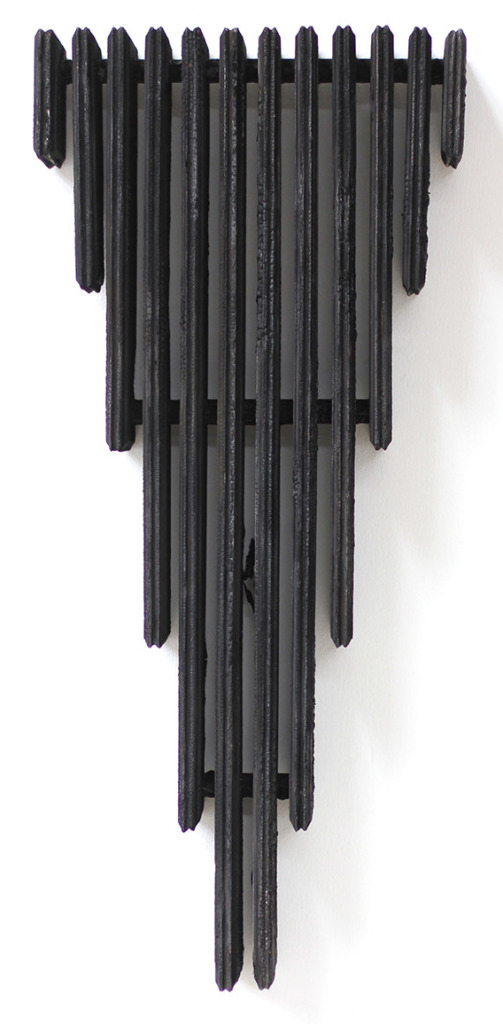
Andrew Sunley Smith, Continual Combustion / Continuous Exhaustion No 4, 2016, birch plywood, birchwood, oxygen, acetylene, steel, 730 x 325 x 100mm. Photograph courtesy of the artist
Andrew Sunley Smith has constructed a series of abstract sculptural forms on-site at FAC. Incorporating radiators, coolers, dissipators and engine structures, Sunley Smith’s quietly violent works act as totemic sentinels to an industrial era of mass resource consumption.
For Sunley Smith his blackened forms, hand crafted by combustion, are an embodiment of the breakdown of industrialised culture and the accompanying relentless consumption of fossil fuels.
“If we can see our culture as an engine, it is the most direct and best metaphor we have. Engines constantly consume, burn and exhaust as they continually move forward. Our houses, buildings, cities, and circuits are all engines. There is still very little we do on a daily basis that does not involve burning or consuming fossil fuel and resources,” Sunley Smith said.
Clyde McGill’s Dolorosa tells of a family caught between borders. Trading in an unforgiving market place where hope and charity are not the currency, the work speaks to the human impact of political upheaval and resource-driven war mongering.
McGill will suspend amplified wires throughout the gallery, creating an interactive soundscape above a series of paintings. In a series of performances every Friday to Sunday throughout SPAN, he will recount the story of the displaced family’s journey towards asylum as the audience responds, plucking and playing the unusual instrument.
While Sunley Smith and McGill play with the mechanics and emotional cost of constant movement and consumption, Susanna Castleden considers the objects that enable mobility. In 1:1 Airplane Wing and 1:1 Gangway, she has used frottage – a labour intensive process of rubbing – on maps to capture the remains of an aeroplane wing in an aircraft graveyard in the Mojave Desert, and the gangway of the passenger terminal at Fremantle Port.
The monumental means of transport will stand to scale with Castleden’s 1:1 Gangway stretched arrestingly across FAC’s front.
Olga Cironis and Tanya Lee diverge from the boundaries that divide us to articulate those that we live within, crafting bodily based works that are intensely personal.
Olga Cironis’s Mountain of Words is almost an antidote to the cultural erosion inevitable from mobility and travel. The artist has woven together locks of hair from thousands of people across WA, mapping the places from which people come. Threaded together in a growing ribbon of hair, each individual tress reads as a line in a continuously scrolling story – black, red, green, blue, grey, brown and blonde.
Mountain of Words acts as both an art object and performance with Cironis weaving her hair ribbon, which she aims to make 500m long, in FAC’s Hallway Gallery every Wednesday to Sunday on an amplified ticking loom.
In Curtilage, a three-channel video, Tanya Lee challenges the borders of domestic life. Curtilage refers to the spaces between buildings and delineates the boundaries of private and shared space. The performances in Curtilage test these by showing real-life neighbours performing seemingly absurd, intrusive acts.
In one scene a neighbour brushes another’s hair with a comically long brush, extending from one house into the next, while another waits to be fed cereal by a boy across the adjacent balcony. Throughout the series Lee explores what it means to cross social boundaries, transforming intimate acts of cleaning teeth, brushing hair and being fed into a means of unusual connection.
Each of the works in SPAN tell near universal stories – of community, consuming ecological damage, displacement and desperation. SPAN links personal body space, encroaches on the neighbours, and considers decisions of travel and where and how we live.
For media enquiries contact Communications Assistant Sam Leung at [email protected] or 08 9432 9565.
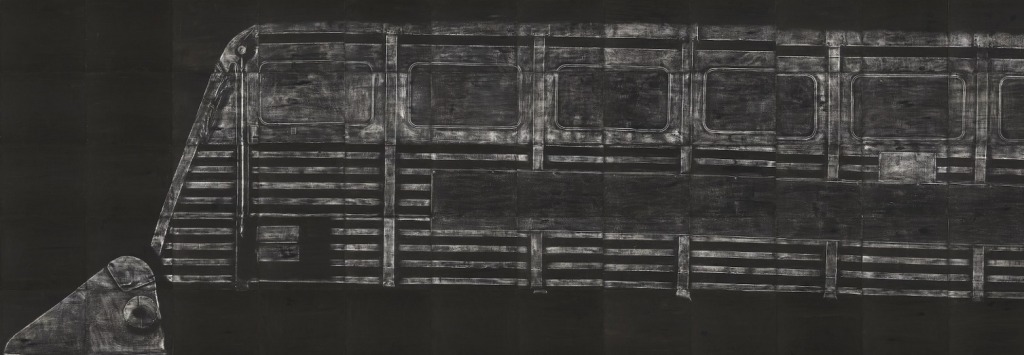
Susanna Castleden, 1:1 Gangway (detail), 2016, rubbing on gesso on paper maps, 3.2 × 15.4m. Photography by Robert Frith, Acorn Photography. Courtesy of the artist
Artist Performances
Olga Cironis: Mountain of Words
Every Wed – Sun | 8 Feb – 26 Mar | 12–3pm | Hallway Gallery | Free
Olga Cironis has travelled across WA, collecting human hair and the stories of its owners. She will weave in FAC’s hallway every Wednesday to Sunday, crafting a 15m long hair ribbon on an amplified, ticking loom.
Clyde McGill: Dolorosa
Every Fri – Sun | 4 Feb – 26 Mar | 12–12:30pm | Kathleen O’Connor & Collections Gallery | Free
Clyde McGill will recount the story of a displaced family and their journey towards asylum as the audience responds, plucking and playing the unusual instrument. Dolorosa sees amplified wires suspended throughout the gallery to create an interactive soundscape.
Artist Biographies
Andrew Sunley Smith lives and works in Fremantle. His work has been included in Glasgow International, Scotland and shown at MCA Sydney, Glasgow CCA, Kunsthalle Mainz, Germany, Brandts Kunsthallen, Odense, Denmark and PICA Perth. His work is held in the national collection of MCA Sydney and the National Library of Australia, Canberra.
Carbon Supremacy was produced with the assistance of FAC’s Artist in Residence program. This project has been supported by the Australian Government through the Australia Council for the Arts, its arts funding and advisory body.
Clyde McGill is a multidisciplinary artist based in Fremantle, working across performance, print, drawing, sound, video and text. McGill’s interests include cultural and social divisions, place and belonging. He is a Fulbright Scholar in Art and his work is held in the National Gallery of Australia and other significant collections.
Dolorosa was produced with the assistance of FAC’s Artist in Residence program.
Olga Cironis is based in Perth. She completed her Masters in Visual Arts/Sculpture and Installation at SCA, University of Sydney in 1996 and is a recipient of numerous art awards and grants. Cironis’ work is held in public and private art collections across Australia and internationally.
Mountain of Words was produced with the assistance of FAC’s Artist in Residence program and residencies across WA.
Tanya Lee is based in Perth. Her work is multidisciplinary, looking at everyday tasks to create humorous, absurd and even futile narratives that subvert the protocols and politics of social environments. In 2016, Lee was selected as a finalist for the John Stringer Prize and also participated in SITUATE Arts Lab in Hobart. Projects in Perth have included Proximity Festival 2014 and her first solo exhibition Personal Space at Fremantle Arts Centre in 2013.
Curtilage was originally commissioned by the Australian Centre for Contemporary Art, Melbourne for NEW16.
Susanna Castleden is based in Fremantle. She is an artist and academic in the School of Design and Art at Curtin University. Her work is held in major national collections and recent awards include the Linden Prize, Burnie Print Prize and Bankwest Art Prize.
Her project has been assisted by the Australian Government through the Australia Council for the Arts, its arts funding and advisory body.
We’ve put together a quick list of tips for our UB40 concert on Tuesday 10 January. Find out where to park, what you can bring and what food and drink options are on offer.
Where to park
There’ll be parking available at John Curtin College’s oval, next door to Fremantle Arts Centre on Finnerty Street for a small fee so make sure to bring change. The oval opens at 5pm and closes at 10:30pm. There’s also limited street parking and paid parking across the road at Fremantle Leisure Centre on Ord Street.
Food and drink
We’ve got plenty of delicious food on offer and a fully stocked bar. You can also bring a picnic in a small soft bag, no eskies, picnic baskets or large bags please.
You can pay with EFTPOS at the bar and most food vendors but there are no ATM’s at the venue.
No BYO
No chairs
You’re welcome to bring a small blanket or fold out cushion (a cushion that has a backrest and sits on the ground) but chairs won’t be allowed into the venue due to space restrictions.
No professional cameras
We don’t allow professional recording equipment and/or iPads into the venue.
No passouts
Out of respect for local residents we don’t provide passouts, so make sure to bring everything you need with you.
Doors open at 6pm
We’ll post playing times as soon as we have them – usually in the week leading up to the show – keep an eye on our Facebook.
Need more information on what to bring? Read our Concert Information or call reception on 9432 9555.
FAC’s exhibition Frank Norton: Painter and Collector celebrates the life of one of WA’s most influential art figures. Frank Norton was the first Official War Artist for the Royal Australian Navy and the Director of the Art Gallery of WA for 18 years (1958–1976), overseeing the development of a new home for the gallery and remaining a prolific artist in his own right.
Available alongside the exhibition is a book written by City of Fremantle Art Collector Curator André Lipscombe detailing Norton’s career and his enduring contribution to the WA art scene. Exhibition runs until Sunday 22 January.
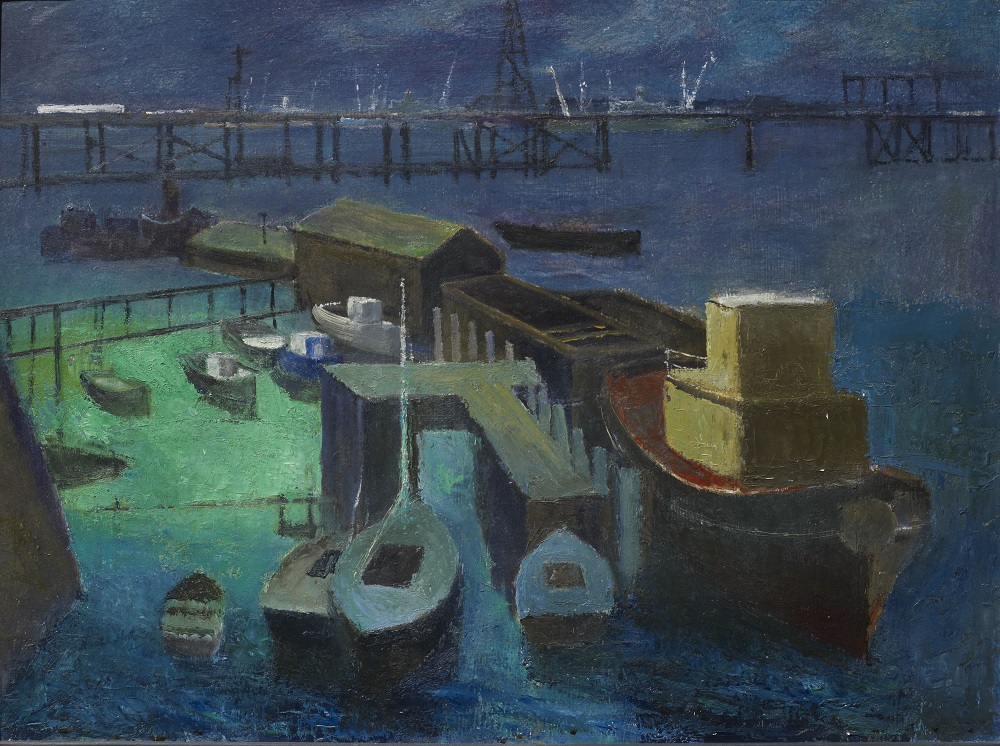
Frank Norton, Fremantle from East Street, 1963, oil paint on board, City of Fremantle Art Collection
Frank Norton: Painter and Collector [extract]
From the Foreword
Dad was a kind, loving, caring father with a Christian faith, a broad knowledge of life, a sense of humour, a love of musicals, and a strong compassion for Aboriginal people and their art.
Sketchbook and pipe were his constant companions, with his eyes, mind and hand his instruments – he had no need for a camera. Even though the majority of his latter artwork was of the land, his heart was still with the sea.
On behalf of my sisters, Janice and Robyn.
Lynne Norton
Painting Fremantle
Norton was familiar with Fremantle and its harbour well before returning to Perth for the Gallery posting in 1958. He had entered the Swan estuary and the port on numerous occasions both during peace time and while on active service. Fremantle was the last port of embarkation for Australian troops heading to war and the point at which returning vessels made landfall in Australia.
During the first months of his appointment as a War Artist, Norton travelled aboard HMAS Brisbane, HMAS Sydney and numbers of escort and convoy vessels. Prior to his time with the Mediterranean Eastern Fleet he recorded HMAS Sydney berthed at Fremantle sporting her grey disruptive camouflage design in July 1941.
In July 1942, at the height of the success of Japanese forces north of Australia, he would be stationed at HMAS Leeuwin barracks in Fremantle.
From this staging point Norton documented Allied warships preparing for the defence of Western Australia. He produced drawings and oil sketches at Fremantle of RAN and Allied ships including submarine fleets and Corvettes, and also wooden ship building yards. It was at this station that he produced his first Fremantle slipway pictures and detailed studies of defensive gun emplacements at South Mole and Swanbourne. Further afield he produced studies of US Navy Patrol Wing Number 10, a Catalina Squadron based at Crawley Bay in Perth and RAAF 25 Squadron at Pearce Airbase.
On his return to Perth after the War Norton briefly returned to working directly from familiar subjects, producing sketches and paintings of landscapes at Fremantle Harbour, including slipways and South Mole, which he had painted fifteen years previously. He completed a number of drawings and at least two oil sketches of ships in dry-dock. These studies would ultimately lead to a more substantive and imaginative studio picture, an elevated view from South Mole Head Lighthouse looking east. Fremantle Harbour 1959 was the first major work painted in his office studio and exhibited at The Society of Artist’s Spring Exhibition at Blaxland Gallery, Sydney and subsequently acquired by the AGNSW in 1960.
Future commissions of Fremantle subjects were forthcoming and included a City of Fremantle presentation picture Port of Fremantle 1964, gifted to Parliament House Perth as well as a picture titled Fremantle 1969, presented in recognition of the appointment of the first honorary Fremantle Freeman Sir Frederick Samson in 1969.[1]
[1] Sir Frederick Samson was the Mayor of City of Fremantle 1951–1972.
This is an extract from Frank Norton: Painter and Collector by City of Fremantle Art Collector Curator André Lipscombe available for purchase from Fremantle Arts Centre.
Exhibition runs until Sunday 22 January.
Find out what’s on at Fremantle Arts Centre this summer in our complete digital guide.

